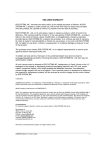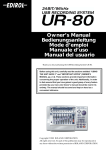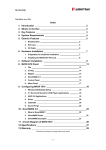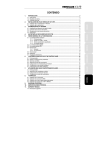Download ESI AUDIOTRAK INCA88 Specifications
Transcript
AUDIOTRAK WARRANTY EGO SYStems Inc. warrants the return policy to its original purchaser as follows; All EGO SYS products, under normal use, will be free from faulty as long as the purchaser owns this product. The terms of warranty is 15 months to EGO SYS distributors considering a 3-month temporary stock period ahead of being sold to the end user. Therefore, the actual terms of warranty is 12 months to the end user. EGO SYS will, at its sole option, repair or replace a product, which is found to be defective. This warranty shall be null and void if, in the sole opinion of EGO SYS, a product failure is the result of misuse, abuse, modification, or misapplication. Except as expressly provided above, EGO SYS products are provided 'as is' without any kind of warranty. No claim is made for merchantability or fitness for any purpose. In no event will EGO SYS be liable for any direct, indirect, consequential, or incidental damages arising out of use of the product. The purchaser must contact EGO SYS or its regional representative to receive prior approval before returning a faulty unit. All such returns must be shipped to EGO SYS' headquarters in Seoul, Korea as being packaged in the original or equivalent protective packaging material (Rack, PCI card, Power Cables, connection cables), with freight prepaid and adequate insurance. If the returned product is deemed to be defective, the repaired or replacement product will be back to you at no extra charge via the carrier chosen by EGO SYS. TRADE MARKS AUDIOTRAK, AUDIOTRAK Inca88 and Miditrak2120 are trademarks of EGO SYStems Inc. IBM is a registered trademark of International Business Machines Corporation. Windows is a trademark of Microsoft Corporation. Other product and brand names are trademarks or registered trademarks of their respective companies. 1 INCA88 For technical support, contact Audiotrak: www.audiotrak.net [email protected] Second Edition. September, 2002 * All features and specifications subject to change without notice. 2 AUDIOTRAK INDEX 1. Introduction to AUDIOTRAK INCA88 .......................................... 5 - FEATURES - ............................................................................................................7 2. Hardware Installation ..................................................................... 10 1. SYSTEM REQUIREMENTS ...............................................................................10 2. PREPARATION FOR HARDWARE INSTALLATION ........................................................ 11 3. INSTALLING INCA88 PCI CARD.............................................................................13 3. INCA88 Software Installation ........................................................ 17 4. Connection to external devices ....................................................... 23 1. INCA88 INPUT/OUTPUTS ......................................................................................23 < INCA88 External Connection Box >.................................................................25 2. BASIC CONNECTION TO AN EXTERNAL DEVICE .......................................................28 5. INCA88 Control Panel .................................................................... 37 [[ NORMAL MODE ]] ..................................................................................................38 1. INPUT SELECT....................................................................................................40 2. MIC PREAMP ......................................................................................................41 3. INPUT LEVEL FADER, LEVE METER ........................................................................41 4. WAVE OUT LEVEL FADER, LEVEL METER ..............................................................42 5. MASTER OUT FADER ..............................................................................................44 6. HEADPHONE AND MONITOR BUTTON .....................................................................44 7. PULL-DOWN MENU BAR ........................................................................................44 [[ MONITORING MODE ]] ...........................................................................................46 1. INPUT SELECT....................................................................................................47 2. MIC PREAMP ......................................................................................................47 3. INPUT LEVEL FADER, LEVEL METER, MONITORING BUTTON .................................47 3 INCA88 4. WAVE OUT LEVEL FADER, LEVEL METER, MONITORING BUTTON ............................. 48 5. MASTER OUT FADER ..............................................................................................48 6. HEADPHONE AND MONITOR BUTTON .....................................................................49 7. PULL-DOWN MENU BAR ........................................................................................49 6. Using Direct Wire( with driver version 3.60 or higher)................ 50 7. Setting in Application ...................................................................... 55 1. WINDOWS MULTIMEDIA SETUP ..............................................................................56 2. 5.1 CHANNEL DVD PLAYER SETUP (POWERDVD SETUP)......................................57 2. ASIO 2.0 – CUBASE, CUBASIS, NUENDO................................................................59 3. CAKEWALK ........................................................................................................62 4. SOUND FORGE .......................................................................................................64 5. WAVE LAB .............................................................................................................65 4 AUDIOTRAK 1. Introduction to AUDIOTRAK INCA88 Thank you for choosing the AUDIOTRAK INCA88. The INCA 88 is a Multimedia digital audio device different from other sound cards. You will be amazed at the various and powerful functions and features of INCA88 when you use it. The INCA88 will satisfy beginners who have just become involved in digital audio to professional musicians who produce music at a professional level with its many features and useful functions. Especially, high quality surround sound will lead you to a true AV experience. INCA88 adopts the ‘E-WDM’ driver model to provide superior data processing and compatibilities. Until now, Windows based drivers such as MME, DirectX, and the WDM driver did not have adequate performance for serious music production. Furthermore, Steinberg’s ASIO and Nemesys’ GSIF drivers do not support full compatibility. These drivers have caused chaos for users and the performance varies from driver to driver. Also, the advent of Windows 2000 adds another hardware and software compatibility issue for the users. AUDIOTRAK employs the E-WDM driver to provide a new solution for users in to take advantage of newer Windows versions and concentrate on their work, not their system. The INCA88 will lead you to the new world of E-WDM. The E-WDM supports MME, ASIO, GSIF, and DirectX taking all the merits of these drivers. One of its advantages is OS support that ranges from Windows 98 and Windows ME to Windows 2000 and XP thus allowing the user to choose the OS of his or her preference. The INCA88 delivers high-quality sound from Windows multimedia tools with various additional features replacing the soundcard in your computer. The INCA88 is capable of playing games using DirectX, playing back MPEG, MP3, wav files, and playing DVD and Video CDs. As the Internet becomes more and more popular, multimedia on the Internet is also useful, such 5 INCA88 as Flash media and internet phones. The INCA88 supports all of these features and, most importantly, 5.1 channel Dolby Surround that will turn your computer system into a DVD AV system better than expensive AV equipment for Hi-Fi users. The INCA88 can be used not only for multimedia but also for the beginner of hard-disk recording to professionals in this field. The E-WDM will work at its best in multi-track, harddisk recording. The INCA88 is compatible with multi-track recording software such as Cakewalk, Cubase, Cubasis, and Nuendo; mastering software such as Sound Forge and Wave Lab; software sampler like GigaSampler and GigaStudio, and most Virtual Synthesizers and Virtual Instruments. As the evolution of the computer system continues, digital audio is becoming more and more common. With the INCA88, you can complete your Desk Top Music Production System easily. The INCA88 will be the center of your DTMP system providing high quality sound that can be compared to that of a professional studio and a guide to the world of digital audio music and multimedia. 6 AUDIOTRAK - FEATURES - 20-Bit D/A Converter & 18-Bit A/D Converter The INCA88 employs high quality 20-Bit A/D converters and 18Bit D/A converters to provide a very low S/N ratio in A/D D/A converting and top-quality sound in recording and playback. 8 In / 8 Out Analog audio Input/Output The INCA88 provides 8 In / 8 Out analog 1/4” phone jack ports with -10dBV reference level that allows connection to most equipment of your choice. 5.1ch. Dolby Surround The INCA88 can be used for 5.1 channel Dolby Surround sound. You will need a DVD-ROM and DVD player software to build a high-quality surround system using a Dolby Surround DVD player in your computer. Also, you can produce surround audio with software capable of producing surround sound. Simultaneous 8 ch. recording and 8 ch. Playback – Full-Duplex The INCA88 supports full duplex, 8-channel recording and playback that is suitable for multitrack recording. In multi-track recording, you can record multiple tracks in your software while monitoring the tracks that were previously recorded. 7 INCA88 S/PDIF Optical, Coaxial digital output The INCA88 has S/PDIF digital input and output ports in optical and coaxial connections that will minimize the loss of signal when transferring digital data to or from other digital equipment including MD and DAT. CD-ROM analog input The INCA88 has an analog input port to connect the CD-ROM driver to an analog output that allows you to listen or record an audio CD with your CD-ROM drive. Various Sample Rate Support The INCA88 supports various sampler rates from 32kHz, to 44.1kHz to 48kHz. Specifically, the INCA88 detects your sample rate automatically to select the appropriate sample rate. You will just need to set up the sample rate in your software to have the INCA88 set it accordingly. Internal Mixer for analog monitoring The INCA88 inputs (Analog, Mic, CD-ROM) are connected to analog outputs in order to monitor inputs by the internal mixer. Also, it is capable of monitoring the input source with a wave file being played at the same time. 8 AUDIOTRAK 32Bit PCI Bus Mastering Usually, a PCI card and a PC system exchange data via a 32-bit PCI bus. The INCA88 adopts PCI Bus Mastering that makes a low-CPU load possible to enable faster data processing and optimized CPU performance. PCI bus mastering allows more plugins to be used in the audio software. 2 MIC Preamp The INCA88 can be connected to 2 mics directly in order to record onto your hard disk drive. The Mic inputs have built-in mic preamps that amplify the mic input signal to the proper level where you can monitor or record. This allows the user to have more flexibility in the digital recording environment. Also, the mic inputs provide 12V Phantom Power that supply 12 V electrical power to condenser mics. The users can connect a mic directly into INCA88 Mic input without an external power supply. Dual headphone Output The INCA88 provides 2 headphone outputs with a headphone preamp through which the users can monitor what they are working on. 9 INCA88 2. Hardware Installation The INCA88 requires a 3-step installation: ‘PCI card installation’, ‘Connection to an external device,’ and finally ‘Driver installtion.’ The ‘PCI card installation’ step involves placing the INCA88 PCI card into the PCI slot and connecting it to the included breakout box. In the ‘Connection to an external device’ step, you will understand how to connect the INCA88 to other devices such as a mic, amp, mixer, and a recording device such as an MD or DAT player. ‘Driver installation’ is having the operating system in your computer recognize the INCA88 and building the communication channel. 1. SYSTEM REQUIREMENTS To take advantage of the INCA88 and its full capacity, the computer specifications are very important. Even though the INCA88 is built to have low-CPU dependability, the computer needs to meet some requirements in order to get maximum performance. The INCA88 is not just a simple soundcard, but a multimedia digital audio device with various functions. Therefore, the performance of the INCA88 is affected by the computer specs that are required to process the vast amount of digital data. A faster CPU, faster hard disk, and larger amounts of RAM are recommended. Minimum System Requirement 1. Intel Pentium II CPU or equivalent AMD CPU 2. 64MB of RAM 3. One available PCI slot 4. Microsoft Windows 98/ME/2000/XP operating system 10 AUDIOTRAK Recommended System Requirement 1. Intel Pentium III CPU or equivalent AMD CPU 2. More than 256MB of RAM 3. One avaiable PCI slot 4. Microsoft Windows 98/ME/2000/XP operating system 2. Preparation for hardware installation The INCA88 PCI card and other components in the computer can be easily damaged by electrical shock. You need to use an anti-static device that can discharge the static electricity of your body to avoid potential static damage to the cards. 1. The AUDIOTRAK INCA88 PCI card is placed into the anti-static plastic pouch as it is packaged. Do not open the pouch before you install the card. 2. Turn off the computer power and remove the power cable from your computer power supply. <Picture 2-1 > 11 INCA88 3. Remove the computer cover. Make sure that you have an available PCI slot in your motherboard to install the ICNA88. Please, refer to your computer user’s manual to remove the cover. <Picture 2-2 > 4. To avoid possible static shock to the computer parts, discharge it by touching the computer case or something grounded. We recommend you to use an anti-static device such as an anti-static wrist band. 5. When you need to hold the INCA88 PCI card, please, hold it on the guide. Do not grab the card by the board. 12 AUDIOTRAK <Picture 2-3 > 3. Installing INCA88 PCI card 1. Please look for an empty PCI slot. If you do not know which one is an actual PCI slot, please, read the following ; <Picture 2-4 > There are 3 kinds of slots in recent computers. The PCI slot is most common and is used for different types of devices from the soundcard to the modem. Usually, the PCI slot is the white-colored slot. The ISA slot is used in older computers and it is marked with a black slot. The 13 INCA88 AGP slot is only for the videocard and is the most recent type of slot. It is marked with a brown slot and is located close to the CPU. It will be not too hard to find the PCI slot for the INCA88. 14 AUDIOTRAK 2. If there is a guide next to the empty slot, please remove the guide using the proper screwdriver. <Picture 2-5 > 3. Next, put the INCA88 PCI card into the slot and make sure it is placed in the slot correctly. The card will fit into your slot and then tighten the screw. <Picture 2-6 > 4. Close the computer case. 15 INCA88 5. After finishing the installation of the PCI card, connect it to the breakout box using the provided cable. <Picture 2-7 > 16 AUDIOTRAK 3. INCA88 Software Installation After completing the installation of hardware for the INCA88, you need to install its software to use it under Windows. The software installation is not too hard, even for computer beginners. Just follow the steps below and you will complete it without any problems. The installation steps under Windows 98SE, Windows ME, Windows 2000 and XP are a little bit different from each other. Setting up under Windows ME and Windows 2000 is described here. Installtion under Windows 2000 1. After the hardware installation, turn on your computer. Windows will automatically recognize the INCA88 showing the message that it detected a ‘PCI Multimedia Audio Device’. 2. The “Add new hardware wizard” will pop up as the following window. Select “Add/Troubleshoot a device” then, press ‘Next.’ <Picture 3-1 > 17 INCA88 3. Select “Search for a suitable driver for my device[recommended].” <Picture 3-2 > 4. Specify the location of the driver. Insert the provided CD into the CD-Rom drive and select ‘CD-Rom drive.’ ( If it’s failed, You can also copy the Inca88 driver to your hard disk.) <Picture 3-3 > 18 AUDIOTRAK 5. Now Windows will recognize the INCA88 after searching for the installation files in CD-Rom drive( or your har disk) and copy them to the system. <Picture 3-4 > * On Windows 2000 and XP, there might be a message appeared that says “The software has not passed Windows Logo testing to verify its compatibility with Windows XP.” You can simply ignore it and just select ‘Continue Anyway’. Though, the message is appeared, the driver is completely tested and verified by manufacturer(ESI) and safe to use it. Windows will continuously install from Inca88 E-WDM Wave-1 to Wave-6. And finally Windows will recognize and install ‘Inca88 Midi(Miditrak 2120-Optional MIDI Interface)’. Even though, several devices will be recognized and installed, just follow step by step. When your system keeps asking restart the computer, just ignore that and keep going to install. When all the drivers are installed and the system doesn’t ask driver install any more, restart the computer. 19 INCA88 <Picture 3-5 > <Picture 3-6> 20 AUDIOTRAK <Picture 3-7> <Picture 3-8> 21 INCA88 6. Then, all required software is installed and Windows will ask you to restart the system. Restart the computer. <Picture 3-9> 10. After rebooting, go to ‘My computer->Control panel->System->Device Manager.’ Check the devices ‘INCA88’ and ‘INCA media bridge’ under Sound, Video, and Game controllers. 22 AUDIOTRAK 4. Connection to external devices The INCA88 is not a simple soundcard but a multimedia digital audio card that can be used for different purposes. Basically, INCA88 is a digital audio interface with multiple inputs and outputs that can be confusing when you connect it to external equipment. However, as long as you understand the basics of making a connection, you can adapt it to more complex connections. 1. INCA88 Input/Outputs The INCA88 consists of a PCI card and a breakout connection box. The PCI card can be connected to an external box by its connection port. Analog connections are made using its breakout box. The SPDIF digital output is located on the PCI card. There is a connector for the Miditrak 2120(Optional), a 2-in, 2-out MIDI interface. All <Picture 4-1 > INCA 88 PCI Card 23 INCA88 1. Connector for the breakout box Using this connector, the INCA88 PCI card can be connected to its breakout external box. Use the provided 44-pin cable to connect and fasten the screws. It is recommended to connect it while the computer power is off. Also, turn down or turn off the external devices connected as it could damage the equipment.. 2. Coaxial SPDIF output The INCA88 has a stereo digital coaxial output that can be connected to other digital equipment by an RCA cable. You can use it with an external device with digital inputs such as a DAT machine. - The Coaxial digital output sends out the same signal as Analog Output 7 and 8. Set the audio output as output 7 and 8 to send out the desired audio to digital output. - Even though the same RCA cable is used, the digital output is different from analog. The digital output uses 1 RCA port to send out a stereo signal whereas analog needs to use a couple of ports to send out the stereo signal. 3. Optical SPDIF output The INCA88 has a stereo digital output in optical format. You can connect it to an external device that is using the optical input as a digital input. It can be used to connect to an MD or CD recorder. - The Optical digital output sends out the same signal as Analog Output 7 and 8. Set the audio output as Output 7 and 8 to send out the desired audio to the digital output. Caution !!!– The above-mentioned Coaxial and Optical outputs send out the same signal that comes out from Analog Output 7 and 8. You cannot set them to send out other sources. 24 AUDIOTRAK 4. D-OUT – 2 pin digital connector You can connect to an internal device using a 2 pin cable. This connector can be used to send out the SPDIF digital signal to another internal device such as another soundcard. The signal that comes out of this connector is the same as the Coaxial and Optical signal. Caution !!! – The Optical digital outputs cannot be used for ‘INPUT MONITORING.’ Please, use analog outputs for this purpose. 5. CD In – CD Rom audio input Most CD-Roms installed in your computer have 4 pin analog outputs that can be connected to the INCA88 ‘CD In’ for your listening pleasure. An audio CD can be played in your CD-Rom that sends out an analog signal to the INCA88 through this connection. Use the proper cable to connect to a CD-Rom and enjoy CD audio from the INCA88. 6. Miditrak 2120 Connector The INCA88 can be expanded to an audio and MIDI interface by attaching the optional Miditrak 2120 from AUDIOTRAK. The INCA88 will have 2-in 2-out 32 channel MIDI functions by adding the Miditrak 2120. The Miditrak 2120 does not require any power supply or any drivers to be installed. < INCA88 External Connection Box > The INCA88 external connection box is for the main analog inputs and outputs. Most of the connections to external devices need to be done via this breakout box. You can connect amplifiers, microphones, headsets, mixers, and synthesizers. 25 INCA88 1. Analog Inputs 1~8 Inputs of the INCA88 are –10dBV unbalanced analog inputs using 1/4” phone jacks. These inputs can be used to receive signals from various external devices to record or monitor inputs. <Picture 4-2 > Analog Inputs 1~8 2. Mic Inputs – input 1,3 : Mic preamp with phantom power Among analog inputs 1 to 8, inputs 1 and 3 can be used for microphone inputs. You can use two mics at once as the INCA88 provides much better flexibility. These mic inputs are equipped with mic preamps and phantom power. 3. Analog outputs 1~8 The Analog Outputs of the INCA88 are the main outputs to send out the signal processed by the INCA88. The INCA88 provides 8 analog outputs for the convenience of users. Outputs are – 10dBV unbalanced analog using a 1/4” phone jack. You can connect to an amp or a mixer. CAUTION!!! – The INCA88 operates in 2 different modes. When the ‘Headphone and Monitor’ button on the INCA88 control panel is not selected, it is in “Normal Mode.” When the button is engaged, the INCA88 goes into “Monitoring Mode.” Depending on these modes, analog outputs 1~8 work with different functions. 26 AUDIOTRAK - Normal Mode – Analog outputs work as 1~8 wave output ports as assigned in various applications. Also, with Input monitoring, inputs 1~8 will be monitored by outputs 1~8. <Picture 4-3 > <Picture 4-3 > Analog outputs 1~8 This ‘Normal’ mode will be used for ‘Dolby Surround 5.1channel.’ Outputs will be turned into a surround setting automatically as you play Dolby Surround supporting DVD. <Picture 4-4 > <Picture 4-4 > Dolby Surround 5.1channel 27 INCA88 -Monitoring Mode – Analog outputs 1,2 become a stereo master output for audio from the INCA88. The Outputs 3 and 4 each become a stereo headphone output that send out the same audio as outputs 1,2. In this mode, the INCA88 will have a stereo master output with dual stereo headphone outputs. The outputs 5~8 will be used for surround out in this mode. <Picture 4-5 > Stereo Monitoring Mode 2. Basic connection to an external device The INCA88 is a piece of multimedia digital audio equipment that allows various uses. This means there are many different ways to connect other devices to the INCA88. Even more, it has 16 channels of audio inputs and outputs that make connections a bit confusing. However, once you understand the basics, you have flexibility in making several types of connections. 1. Analog inputs (1~8) take signals into the INCA88 and the computer. A regular CD-player, MD, and any other analog source can be connected to listen or record. Also, a sound module, sampler, and synthesizer can be connected to record their outputs. Inputs 1~8 can be used as pairs of stereo like 1-2, 3-4, 5-6, and 7-8 or as individual mono inputs like 1, 2, 3, 4… . Also, they can be mixes of mono inputs and stereo inputs. These combinations 28 AUDIOTRAK can be used for the intents and purposes of the user. A total of 8 inputs will provide superior flexibility to users in their audio work environment. <Picture 4-6 > <Picture 4-6 > Example of usage of Analog inputs 1~8 29 INCA88 2. Mic inputs (1,3) can be used to connect up to two mics at the same time. A dynamic mic or condenser mic that needs phantom power can also be connected. You can record a voice or musical instruments such as guitar, bass, and piano. <Picture 4-7 > Example of usage of Mic inputs 30 AUDIOTRAK 3. Analog outputs (1~8) are designed to be heard through a mixer, amp, and speakers generally. Output ports will function differently in ‘Normal mode’ than ‘Monitoring mode.’ Please, be familiar with these functions to take full advantage of the INCA88. -Normal Mode In Normal mode, analog outputs 1~8 works as output ports of a wave device. You can set up these in your application or Windows Multimedia properties. This Normal mode is usually used for multiple outputs when you use a mixer or a multi-track recorder. You can use these in multitrack recording programs such as Cubase and Cakewalk. <Picture 4-8 > Normal mode will also be used for the INCA88 5.1channel Dolby surround sound system. By playing Dolby Surround supporting DVDs, the INCA88 will go into Surround setup automatically. You need to connect the speakers to each assigned output and place the speakers according to Surround specifications. The following picture will describe a generallyrecommended speaker setting for Surround sound. <Picture 4-9 > 31 INCA88 <Picture 4-8 > Analog 1~8 outputs 32 AUDIOTRAK <Picture 4-9 > Dolby Surround 5.1 channel setting 33 INCA88 - Monitoring Mode Monitoring Mode is set completely different from that of Normal Mode. Outputs 1-2 become the INCA88 Stereo Master Output. The INCA88 output sources will come out of this stereo master output. Both Outputs 3 and 4 become a stereo headphone output to use 2 pairs of headphones. The same signal will come out of the master output and the two headphones sets. <Picture 4-10 > 34 AUDIOTRAK <Picture 4-10 > Monitoring Mode 35 INCA88 5. Digital output (Coaxial, Optical) can be used to record your wave output, MP3 files, or wave files directly to an MD, DAT, or CD Recorder. These two ports (Coaxial and Optical) will send out the same signal as that of analog outputs 7,8. The signal is a stereo signal in S/PDIF format. So you can connect S/PDIF compatible devices suce as an MD, DAT, or CD Recorder to transfer audio data with minimal signal loss. <Picture 4-11 > <Picture 4-11 > Digital outpus 36 AUDIOTRAK 5. INCA88 Control Panel If you complete the INCA88 hardware installation and software setup, you need to learn about the INCA88 Control Panel. This control panel is where you control your setup for the INCA88. The INCA88 Control Panel is built for easy control. However, it could look complex since there are many inputs and outputs. All input and output controls are the same. So, if you learn about one control, you can use the others easily. After successfully installing INCA88 hardware and software, you can see the icon INCA88 icon in the system tray. This is the INCA88 control panel icon and the control panel will be launched as you click on this icon. The INCA88 Control Panel operates in 2 different modes. They are explained in the previous chapter. You can go into the different mode by pressing the ‘Headphone and Monitor’ button on the control panel. 1. Normal Mode - ‘Headphone and Monitor’ : OFF. 2. Monitoring Mode - ‘Headphone and Monitor’ : On. CAUTION !!! Input Monitoring – Input monitoring is one of the INCA88’s functions to send out an input signal directly to the output ports for monitoring purposes. For example, you can monitor mic inputs through INCA88 analog output. 37 INCA88 [[ Normal Mode ]] It is in ‘Normal Mode’ when the ‘Headphone and Monitor’ button is not engaged in the top-right corner of the INCA88 Control Panel. You cannot do Input Monitoring under Normal Mode. The biggest difference between Normal Mode and Monitoring Mode is that you cannot check out the source of the input. If you select the INCA88 in your application as your output device, the signals coming into the INCA88 will be recorded onto your hard disk. If you wish to monitor inputs and record at the same time, please choose ‘Monitoring Mode.’ You cannot use headphone outs in Normal Mode. ‘Normal Mode’ can be used for 5.1 channel Dolby Surround Sound system. For surround sound, there is no additional setup required. As you play a DVD movie with a software DVD player, the INCA88 outputs turn into surround speaker outputs. OUTPUT SPEAKER 1 2 Front Left Front Right 3 4 - - 5 6 Rear Left Rear Right 7 8 Center Sub Woofer <Picture 5-1> 5.1 channel surround speaker setting 38 AUDIOTRAK Please refer to the chart and previous chapter (4-2. Basic connection to external devices). <Picture 5-2 >INCA88 control panel in Normal Mode 39 INCA88 1. INPUT SELECT The Input select area is where you select your input source. Basically, the INCA88 uses a 10dBV unbalanced mono line input. Among the 8 inputs, inputs 1,2,3,4 can be used as line inputs, mic inputs, and CD inputs. In more detail: you can use inputs 1,2 as line inputs or mic inputs by your selection. Inputs 3,4 can be used as line inputs, mic inputs, or CD inputs by your selection. Your selection will be a source when you record the inputs. For example, if you select ‘INCA88 Audio Driver 1’ in your application, your can record inputs selected for input 1,2 between the Line input and Mic input. CAUTION !!! Ex. – If you want to record an audio CD in Cakewalk, 1. Select CD for inputs 3,4 in “Input Select” on the INCA88 Control Panel. 2. Select ‘INCA88 Audio Driver 2’ for your recording source in Cakewalk. 1. LINE – line input select If ‘Line’ is selected for inputs 1,2 and 3,4 in “Input Select” on the INCA88 Control Panel, the INCA88 will take the –10dBV line input as its source. The rest of the inputs, inputs 5,6,7,8 will always take the –10dBV line input as its source. 2. MIC – Mic input select The INCA88 can record audio from microphones. A mic can be connnected to input 1 and 3 only, unless you use a separate mic preamp. When the mic buttton is pressed, the mic connected to input 1 becomes input 1,2 and the mic connected to input 3 becomes input 3,4. 3. CD – CD input select As you press this button, The INCA88 will take the input from the CD-ROM connection on the PCI card. You can play and record CD music from your CD-ROM drive. You can only select this on inputs 3,4. 40 AUDIOTRAK 2. MIC PREAMP Select the proper settings for your mic. You can select the input level and phantom power. This will work when you select ‘MIC’ in Input Select. 1. +20dB When this button is engaged, the mic preamp will amplify the level of the input from the mic by +20dB. The mic input level is less than the line input level, and this mic preamp needs to be on when you use mics. 2. PHANTOM When you use a condenser mic that requires external power, the INCA88 will supply 12V power to the mic. This is called Phantom Power and this will allow you to plug a mic directly into the INCA88 input without going through an external mixer or an additional mic preamp. You can turn the mics on and off that are connected to the inputs 1 and 3 individually. Again, the INCA88 provides 12V phantom power to the mic. 3. Input Level Fader, Leve Meter The Input Level Fader will control the input volume level of inputs 1~8 of the INCA88. All 8 input level faders work in the same way. 1. Level Fader The Level Fader controls the input level. You can control levels 1~8 individually or as pairs like 1-2,3-4,5-6, and 7-8 in stereo. Move the mouse pointer over specific port fader to adjust the level individually. To adjust a stereo level, move the mouse over the middle of the stereo ports. The selected port fader(s) will turn into a brighter color to indicate the selected port(s). 41 INCA88 You can move the fader in three different ways. Basically, the volume level can be adjusted by ±1.5dB. - Drag the fader as you press the left mouse button. - Select the fader with the mouse cursor and adjust with the mouse wheel. You can select the steps from the pull-down menu, ‘Config’ ->’Mouse Wheel’. - Select the fader with the mouse cursor and use the up and down arrows of your keyboard. 2. Level Meter The Level Meter will display incoming signal levels. This will be active when there is a signal coming from an input port. All 8 channels have their own meter so you can compare the inputs and adjust them. You can use the level meters even though you do not monitor the inputs. 3. Input Level Indicator The Level Indicator shows the current level set for the input. By comparing these, you can set up the input level with external devices and other inputs. You can adjust it by moving the input level fader. 4. Wave Out Level Fader, Level Meter The Wave Out Level Fader is the output volume control fader that controls outputs 1~8 of the INCA88. All 8 level faders act the same so you need to learn only one. You can adjust the volumes of wave files, multimedia files, and the sound of games that the INCA88 PCI card controls. The term ‘Wave’ means the sound that is generated by the computer. The input monitoring level can not be controlled here. 1. Level Fader The Level Fader will change the level of the “Wave Out” volume. You can control outputs 1~8 individually or control the stereo pairs like outputs 1-2,3-4,5-6, and 7-8. You need to move the 42 AUDIOTRAK mouse pointer over the specific port fader to adjust it individually or move the mouse pointer over the middle of the two ports to adjust it as a stereo channel. If the port fader(s) is selected, it will turn into a brighter color. You can move the fader in three different ways. Basically, the volume level can be adjusted by ±1.5dB. - Drag the fader as you press the left mouse button. - Select the fader with the mouse curser and adjust with the mouse wheel. You can select the steps from the pull-down menu, ‘Config’ ->’Mouse Wheel’. - Select the fader with the mouse cursor and use the up and down arrows of your keyboard. 2. Level Meter The Level meter displays the signal level of the wave signal. You can see the level of each output to compare them and adjust the level on the basis of these meters. If you wish to send out a wave file to an external device, refer to the level meters to adjust the signal to the proper level. 3. Output Level Indicator The Output Level Indicator shows the current level setting for each of the outputs. You can compare the output levels based on this indicator in order to adjust the output level to a desired level. Move the output level fader in order to set it to a proper level. CAUTION !!! – The Wave Out Level Fader can be misunderstood to control the outputs of INCA88 that comes from output ports 1~8. The INCA88 Wave Out Level Fader is able to control the level of the waves that are generated by the computer. It can NOT control all output levels. 43 INCA88 5. Master Out Fader The Master Out Fader controls the entire output level of the INCA88. However, in Normal Mode, this fader is set to 0 dB. Therefore, you need to set the Input and Output levels in each port. 6. Headphone and Monitor button The Headphone and Monitor button decides the modes of the INCA88. When the button is engaged, it is in ‘Normal Mode’ and, when the button is not engaged, it is in ‘Monitoring Mode.’ 7. Pull-down Menu Bar The INCA88 Control Panel includes a pull-down menu bar that contains the configuration for the Control Panel. This Menu Bar consists of a File menu and a Config menu. 1. File - Exit File – Exit will terminate the INCA88 Control Panel but it will not shut down the Control Panel. You can launch the Control Panel by clicking on the INCA88 icon in the system tray. 2. Config – Mouse Wheel The Config-Mouse Wheel will control the mouse wheel adjustment. When you use the mouse wheel to adjust the volume level, the adjustment step is set to ±1.5dB. You can configure the adjustment steps to your preference. - Step 1 : When you move the mouse wheel one step, the fader will move by ±1.5dB. - Step 2 : When you move the mouse wheel one step, the fader will move by ±3.0dB - Step 4 : When you move the mouse wheel one step, the fader will move by ±6.0dB. - Step 8 : When you move the mouse wheel one step, the fader will move by ±12.0dB. 44 AUDIOTRAK 3. Config – Sample Rate The Sample Rate option gives you three sample rates available for the INCA88. The INCA88 supports 32 kHz, 44.1 kHz, and 48 kHz. The sample rate must be selected here, then the same sample rate has to be set in your application. 4. Config – Buffer Size This will decide the latency of the INCA88. The INCA88 provides 4 different sample buffer size; 64 sample, 128 sample, 256 sample, and 512 sample. In general, 64-sample buffer size results in 3 milisecond of latency. 5. Config – Factory Default This returns all INCA88 configurations to their default setting. 6. Always On Top This will set the INCA88 Control Panel to always display over other windows. If this is not selected, the active windows will be set over the INCA88 Control Panel. 45 INCA88 [[ Monitoring Mode ]] The INCA88 will operate in Monitoring Mode when the ‘Headphone and Monitor’ button is engaged. This mode allow the user to directly monitor the inputs of the INCA88 through the outputs. The INCA88 Monitoring Mode supports direct monitoring that routes the inputs directly into the outputs. Monitoring through the software could affect the quality of sound and create a time gap in the monitoring process latency. By using hardware direct monitoring, monitoring sound is as close as the inputs. You can record inputs regardless of the monitoring. Also, you can use headphones for monitoring. CAUTION !!!!! - In ‘Monitoring Mode’, the INCA88 outputs 1~8 perform different functions. - 1-2 output become the master monitoring outputs. - Outputs 3 and 4 each become the stereo headphone output to provide dual headphone outs. The outputs of the headphones are the same as that of the master output 1,2. - Outputs 5,6,7,8 work as normal ( wave out 5,6,7,8 ). 46 AUDIOTRAK <Picture 5-3 > 1. INPUT SELECT The setup of the Input Select in Monitoring Mode is the same as that of ‘Normal Mode.’ However, you need to select the right input source for your input. Since the same input port can be used for LINE, MIC, or CD, if you select the wrong source, your input will be incorrect. For example, if you select Mic input, but you actually use Line input, your input signal is too loud and distorted, and could possibly damage your amp or speaker. To change the input source between MIC <-> LINE <-> CD, you need to select the input source first and turn off the ‘M’ button at the bottom of the Input Level Fader. 2. MIC PREAMP The setting of Mic Preamp is the same as the setting in Normal Mode. 3. Input Level Fader, Level Meter, Monitoring button 47 INCA88 ‘Mix’ – Monitoring button – The Input Level Fader can be used to adjust the input level for inputs 1~8. You can adjust it the same way as in Normal Mode. However, there is a ‘Mix’ button underneath of each level indicator in Monitoring Mode. When the button is engaged, you can monitor the input for that input port. The inputs with the ‘Mix’ button on can be monitored through the master outputs 1,2 and/or the headphone outputs 3 and 4. All the inputs with ‘Mix’ button on are sent to the master outputs. 4. Wave Out Level Fader, Level Meter, Monitoring button ‘Mix’ – Monitoring button - The Wave Out Level Fader controls the wave volume of INCA88 outputs 1~8. You can adjust the level the same way you do in Normal Mode. The ‘Mix’ button underneath the fader needs to be engaged to monitor the wave out on that port. The signals to the output port will be sent to the stereo Master output 1,2 when the button is engaged. You can monitor selected Wave outs through the master output 1,2 and the headphone outputs 3 and 4. CAUTION !!! – The Wave Out Level Fader can be misunderstood to control the outputs of INCA88 that comes from output ports 1~8. Especially in Monitoring Mode, it could be confusing. The Wave Out Fader 1,2 controls the level of the device, Wave 1,2 ; but the Master Level Fader controls the actual output that comes from Output ports 1,2. Again, The Wave out Fader 1,2 controls the volume level of the wave device 1,2 - not the Master Out 1,2. Master out 1,2 can be adjusted by the Master Out Fader. 5. Master Out Fader The Master Out Fader controls the INCA88 master output level. In ‘Monitoring Mode’, you can adjust the levels using this fader (in Normal Mode, it is set to 0dB ). In Monitoring Mode, outputs 1,2 are used for a stereo master output and outputs 3 and 4 for the headphones. Use the Master Out Fader to adjust the level of this output. Adjust the input level by using Input Level 48 AUDIOTRAK Fader and control the wave out level using the Wave Out Fader to get a well-mixed sound. - ‘M’ – Mute button : You can press this button to mute the master output. The button will turn into ‘M’ and it will mute all the analog outputs. 6. Headphone and Monitor button By pressing this button, INCA88 will go into two different modes. When the button is engaged, it is in Monitoring Mode. When it is not engaged, it is in Normal Mode. 7. Pull-down Menu Bar All the settings are the same as in Normal Mode. 49 INCA88 6. Using Direct Wire( with driver version 3.60 or higher) By clicking this menu on Inca88 console(driver version 3.60), DirectWire window will be appeared. DirectWire is a unique feature of E-WDM driver that make possible to transfer digital audio data within different applications using same/different drivers. As you can see, MME, Multi-MME, ASIO and GSIF indicate driver names of WT192M. Along the vertical channel indicate number, output and input ports of each driver are showed. Just click desired output number of the driver and drag it to the input of the driver you want to record the source. MME section means normal application's I/O, ex.) WinAmp, WaveLab, Cakewalk ... Multi-MME section means SONAR, PowerDVD, Win DVD I/O ... ASIO section means Cubase, Logic, Nuendo, Reason I/O ... GSIF section means GigaStudio I/O. 50 AUDIOTRAK EX1. Recording from Winamp to WaveLab EX2. Recording from Winamp to Sonar EX3. Recording from Winamp to Cubase 51 INCA88 EX4. Recording from Sonar to Cubase or Vice versa EX5. Recording from Power DVD 5.1 to Sonar 52 AUDIOTRAK EX6. Recording from Power DVD 5.1 to Cubase EX7. Recording from GigaStudio to Sonar 53 INCA88 EX8. Recording from GigaStudio to Cubase 54 AUDIOTRAK 7. Setting in Application INCA88 is a multimedia digital audio device designed to be used for audio work in a Windows environment. It has a wide range of usage from game sound to DVD surround sound. It is very easy to set up the INCA88 in the multimedia setup of the Windows Control Panel. Also the INCA88 can be used with digital audio software to perform hard-disk recording. This chapter includes the set up guide for some common recording software. Especially, the INCA88 uses the E-WDM driver that supports the audio dedicated drivers such as MME and ASIO. This chapter only contains the basic setup for some of the software. For more detailed info, please refer to the manual of the software. 55 INCA88 1. Windows Multimedia Setup - Windows 98SE / ME The Windows Multimedia setup is required to use the INCA88 as the sound system for Windows multimedia applications. Go to ‘My computer -> Control panel -> Multimedia’-> Audio tab. Select the INCA88 Audio Driver as your Playback and Recording device. When you see four INCA88 drivers, INCA88 Audio Driver 1 ~ 4, select proper device for your setting. The INCA88 Audio Driver 1 represents the Input and Output ports 1 and 2 , Driver 2 represents 3 and 4, and so forth. For example, if you select the INCA88 Audio Driver 3, your input and output ports are 5 and 6. <Picture 6-1 > Windows 98SE Multimedia Setup 56 AUDIOTRAK 2. 5.1 channel DVD Player Setup (PowerDVD Setup) The INCA88 can be used with 5.1 channel DVD software player to provide 5.1 channel analog surround sound. Since the INCA88 is built for professional audio, it will deliver optimal sound for your DVD player. You can configure the INCA88 easily to use it for surround sound. Go to ‘My Computer->Control Panel->Multimedia’ and select ‘INCA88 Audio Driver 5.1 ch’ as your Playback and Record device. You will see the ‘INCA88 Audio Driver-1,2,3,4, and 5.1ch’ on the list. The INCA88 Audio Driver 1 is the input and output ports 1 and 2, Drver 2 is 3 and 4, and so forth. The INCA88 Audio Driver 5.1 ch is the driver that works with software DVD players to enable 5.1 channel surround sound. <Picture 6-2> By choosing the INCA88 Audio Driver 5.1ch, the outputs become as follows to provide surround sound. 57 INCA88 OUTPUT SPEAKER 1 2 Front Left Front Right 3 4 - - 5 6 Rear Left Rear Right 7 8 Center Sub Woofer In PowerDVD, select Configuration on the PowerDVD interface. Press the Audio tab, select “Use WaveOut” and “Dolby Surround.” <Picture 6-4> 58 AUDIOTRAK 2. ASIO 2.0 – Cubase, Cubasis, Nuendo The INCA88 supports the ASIO2.0 driver from Steinberg. It works perfectly with Cubase, Cubasis, and Nuendo. For your hard-disk recording: - Cubase After launching Cubase, go to ‘System’ under ‘Audio’ menu. Select ‘ASIO 2 – INCA’ for the ASIO Device and ‘INCA88 Clock’ for the Audio Clock Source. <Picture 6-2 > Cubase Setup 59 INCA88 - Cubasis Settings in Cubasis are the same as Cubase. Select ‘System...’ from ‘Audio’ menu and ‘ASIO 2 – INCA88’ from ‘ASIO Device.’ Select ‘INCA88 Clock’ as your ‘Audio Clock Source.’ <Picture 6-3 > Cuasis Setup CAUTION !!! Cubasis included in this package has a limitation on the number of output ports and other functions. You can upgrade to CubaseVST to use more functions. 60 AUDIOTRAK - Nuendo To use the INCA88 with Nuendo, select ‘Device Setup...’ from the ‘Devices’ menu, then ‘VST Multitrack’ under Devices. Select the Setup tab on the right side. Choose ‘ASIO 2 – INCA88’ as your ‘ASIO Driver’ and ‘INCA88 Clock’ as your ‘Clock Source.’ <Picture 6-4 > Nuendo setup 61 INCA88 3. CAKEWALK When you launch Cakewalk for the first time after installing the INCA88, Cakewalk will automatically start ‘Wave Profiler’ to set a buffer size. In Cakewalk, select ‘Audio...’ from ‘Options.’ Check to see if the ‘INCA88’ is selected as ‘Input Drivers’ and ‘Output Drivers’ under ‘Drivers’ tab. Also check to see that the ‘INCA88 Audio Driver’ is selected as ‘Timing Master’ under the ‘General’ tab. <Picture 6-5 > Cakewalk Setup 1 62 AUDIOTRAK <Picture 6-6 > Cakewalk Setup 2 63 INCA88 4. Sound Forge In Sound Forge, select ‘Options’ from the menu bar. Select ‘Preferences...’ then ‘Wave’ tab. Choose ‘INCA88 Audio Driver’ as your Playback and Record device. Since Sound Forge is 2- track software (though the INCA88 has 4 stereo input and output ports), you need to choose only one of ‘INCA88’s Audio Driver’ (such as 1, 2, 3, or 4). <Picture 6-7 > Sound Forge Setup 64 AUDIOTRAK 5. Wave Lab In Wave Lab, select ‘Preferences...’ from ‘Options’ in the menu bar. Choose ‘INCA88 Audio Driver’ as the Playback and Live Input/Recording device in ‘Audio Card.’ Since Wave Lab is 2track software (though the INCA88 has 4 stereo input and output ports), you need to choose only one of ‘INCA88’s Audio Driver’ (such as 1, 2, 3, or 4). <Picture 6-8 > Wave Lab Setup 65 INCA88 66

















































































![[English] 1 MB](http://vs1.manualzilla.com/store/data/005724727_1-d0907da86b06d0402fef0dce028404c5-150x150.png)
